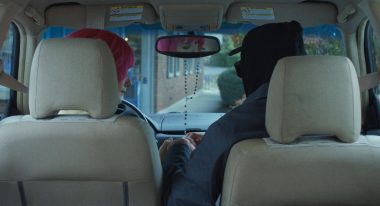 Back to selection
Back to selection
True Crit
Weekly film reviews. by Howard Feinstein
The Wrong Box: Zach Clark’s Little Sister, MoMA’s Sally Bergerless Doc Fortnight
 Addison Timlin in Little Sister
Addison Timlin in Little Sister “I needed structure!” says former goth Colleen Lunsford (Addison Timlin, star-to-be) in a revelatory moment in Little Sister, the latest feature by Brooklyn-based Zach Clark (White Reindeer, Vacation). It is one of two unaffected masterpieces (the other is Ira Sachs’s Little Men, which I’ll review when the increasingly daring Magnolia Pictures releases it) screening at BAMcinemafest (Jun 15-26) that I was fortunate enough to catch early — two for two! Colleen is exasperated trying to explain to her estranged, self-absorbed mom, Joani (Ally Sheedy, better than ever), why she left home to seek out spiritual redemption in a cloistered New York City nunnery. The verbal clash takes place in 2008 during the daughter’s last-minute visit to her Asheville, North Carolina childhood home for a reunion with her recently returned-home soldier brother, Jacob (Keith Poulson), who used to play in a rock band before enlisting and then becoming severely disfigured by an IED in Iraq.

If Colleen has become an angel, Jacob has the thankless part of sacrificial lamb. Biblical themes and motifs keep popping up. An atheist since the age of eight who calls his upbringing religion adjacent, Clark attended Catholic schools for a few years, and is the son of an Episcopal priest mother and a father who at one time taught English in a Catholic high school.
Joani, a lifelong doper from the hippie generation, has a history of manic depression. Her self-mutilated wrists, perhaps inflicted by this egoist to draw attention to her stigmata, bear witness. More than likely the two siblings required anchors to keep from festering the emotional scars inflicted by this formidable character. She has been enabled by passive failed-actor husband Bill (Peter Hedges), whose familial role is the prevention of wavemaking at any cost. Unfortunately for Jacob, he chose a much more earthbound way than Colleen out of a seemingly insurmountable rut, only to fall into a vastly deeper one. His burned face, which he tries to hide from public view by shutting himself in and off, bears witness (a nod to Gerner & Spears Effects).
Colleen’s wounds are not so visible. They are manifest by posture and behavior. She is eerily still and awkward, reticent to interact with others. Asking for anything saps her strength. The Reverend Mother (Barbara Crampton) at Little Sisters of Mercy convent is unsure about the strength of her conviction, but then, so is Colleen herself. Both women understand that the road trip down South will double as a faith check.

The other member of the typically atypical Clarkian family is Jacob’s fiancée, Tricia (the spectacular Kristin Slaysman, giving a very full-bodied interpretation of trailer trash). She and Jacob became engaged — and she moved in — before his Iraq tour. Now, following his return, they still live together even as he has become too self-pitying to reciprocate her unconditional love and lust. I wonder if Clark cuts so often to the strangely docile family chihuahua to offer the viewer a tad of normalcy, relief from dysfunction so exaggerated yet nonetheless firmly rooted in the real world and its problems.
As in his earlier works, Clark balances the melancholy with outsized bursts of joy — a dichotomy embodied by Joani, with her high highs and low lows. On the spur of the moment, Colleen, sporting a blue-gray wig, bursts into lip-synch song and dance (GWAR’s “Have You Seen Me?”), tossing about like a weapon a macabre baby doll. Her energy is no longer dormant.
The musical number marks the beginning of an unplanned, cathartic project of rehabilitation for the siblings. Inserts from old home movies of young sister and brother add a bittersweet poignancy. For the first time, Jacob seems bemused, a glimmer of happiness emerging from beneath his baseball cap and behind his dark sunglasses. The process of discarding these embellishments, pathetic efforts to disguise his visage, becomes a barometer of his grasp of any kind of exultation. He goes back to playing the drums, harder and harder, with more and more passion.

Colleen joins with pals from her high-school goth days in dark skits set to dark songs, which the word surreal does not come close to describing. It’s an updated Rocky Horror offshoot. With the help of DP Daryl Pittman and his own editing, Clark ratchets everything up, with a frenzied camera (the film is almost evenly divided between stationary and handheld), oblique angles, fish-eye lenses, replacing the usual with his own fastidiously warped artistic vision. By the time the entire Lunsford family and a host of friends, in full Halloween regalia, let loose in a kinetic, mushroom-fueled sequence of spontaneous, unchoreographed choreography — well, that’s what it is, plus a fine example of how structure and its lack can operate in tandem. The tight bubble of latent euphoria bursts wide open.
Inspired by a screening of a restored version of Frans Zwartjes’s Medea, a film which has nearly zilch in the way of props, but which he finds “haunting, kinky, moving, new,” Clark (an exceptional writer) slams the remake of Eli Roth’s Cabin Fever at The Talkhouse, elaborating upon his philosophy of reworking and diversifying:
You can do so much with nothing in movies. There are endless opportunities for reinvention. Just when you think an idea has been run into the ground, a simple shift of perspective or the proper execution of an aesthetic idea can breathe new life into a cliche.

White Reindeer (2013) prefigures Little Sister’s schema of peaks and valleys, but with the notion of family reconfigured. The central character, like Colleen, is a young, middle-class woman, a real-estate agent named Suzanne (Anna Margaret Hollyman), whose husband is killed during a break-in just before Christmas and a long-planned trip to Hawaii. Clark inverts the genre of the merry Christmas movie, just as he does in Little Sister for the coming-home film. In White Reindeer, he saddens the season — Suzanne approaches madness — until a slew of declasse hardcore rule breakers, revelers, and substance abusers turn her on to the thrills enjoyed by marginals who make the most of their spots in the netherworld. She is no longer the lonely widow. Their wild, transgressive adventures are a salve for the additional heartache she suffers once she discovers the extent of her husband’s infidelity. Embracing her full self sets her free.
Watching Little Sister, you can’t help but notice the similarities to Douglas Sirk (Clark tops his list of favorite Christmas movies with the master’s 1956 All That Heaven Allows) and R.W. Fassbinder, who more overtly politicizes similar melodramas (although Tim Burton, and through him Ed Wood, are the primary influences that, Clark says, “changed my life”). Little Sister recalls the gorgeous stylized aesthetic Sirk and Fassbinder put to seductive use — the informative distancing effects in their mise-en-scene and montage and the camp spirit that runs throughout their work. Visually, you can call it postmodern pastiche. As for its fundamental ideology, Clark subscribes to what camp historian Jack Babuscio calls its four qualifying characteristics: irony, aestheticism, theatricality, and humor (although I’m not sure he would own up to the first).

In theory, and in Little Sister, camp is not merely kitschy gloss, but something more, functioning, as Babuscio describes it, “in the service of the serious.” In a film with a seriously wounded veteran, the soundtrack is bracketed by Obama’s speeches at an uncertain time of regime change, when hope is arising for America to come out of both a recession and Iraq. Joani’s vehemence in arguments with Colleen attests to the importance of mother-daughter relationships and the gravity of their rifts. Colleen’s old activist friend Emily (Shelley Duvallish Molly Plunk) has become an environmental terrorist; in addition, she has no qualms about crossing acceptable lines to accelerate Jacob’s healing. Another apt quote defining camp is the frequently used “not making fun of but making fun out of.” Isn’t that what the film’s over-the-top performances do, just as in White Reindeer?
Above all else, Clark’s filmmaking has been shaped by exploitation flicks. He came under the spell of the titles handled by one-of-a-kind distributor Something Weird Video at the Video Vault in Alexandria, Virginia, the famous haunt for cinephiles where he ended up working. He found them in a room at the top of the stairs that contained what some call smut; others, inspirational. Like the makers of those films, he works on the cheap, using whatever might be at hand when money is an issue—as it always is. “You can steal the equipment,” he writes at The Talkhouse. “You can shoot on cardboard sets. It doesn’t matter, just make it.” He reviews these movies with the same respect and awe others reserve for grand arthouse fare. After Something Weird founder Mike Vraney died in 2014, Clark wrote the following in a loving L Magazine tribute:
The Tarantinos and Rodriguezes of the entertainment industry have homogenized and commodified exploitation films over the past decade or so, reducing them to wink-wink exercises in disingenuous kitsch. But Something Weird peddled the real deal.
Veteran New Yorker critic Richard Brody has written cogently about how palatable highbrow films have hurt the market for true indies, especially those that don’t easily fit into marketable niches. Polish, a veneer of quality, is more often than not a requirement for membership in the insiders’ club. Clark writes, again at the invaluable Talkhouse:
Just because something isn’t traditionally good doesn’t mean it is without merit. A movie’s imperfections, misguided decisions and outright failures can make it more interesting than so-called professional productions.
Brody maintains that outside-the-box talents lose out more on account of arthouse fare than from incorrectly assumed competition with bigger Hollywood spectacles. He accuses film critics of contributing to the destructive oversight by limiting their reviews to commercial releases or what he hilariously calls “the children of the museum,” films with some kind of institutional support. In response, the recently departed Sam Adams at Indiewire notes the prominent role of editors in the omission. Filmmaker editor Scott Macaulay, in one of his weekly newsletters, sums up the lapse: “Many critics rely on assignments by editors who themselves face pressure by higher-ups to justify their editorial budgets by demonstrating clicks and engagement.” Both Adams and Macaulay throw into the mix the part Facebook plays for editors managing budgets and conceiving of their audiences. Macaulay lumps these factors together, calling them current business roadblocks.
With distribution models in flux, a review may not pull audiences into the cinema, but it can be useful in ancillary, especially VOD. Good luck if you want to see Little Sister right away, in all its ‘Scope glory. It screens one time only (June 17, 9:45 pm) in one of the four theaters (around 200 seats) at the BAM Rose Cinemas — akin to a solo multiplex projection. Come on, it is a multiplex. Future plans are not yet known, or perhaps unannounced.
Clark’s uniqueness — okay, his freakiness — is a mixed blessing. His ideas and strategies for their execution defy pigeonholing, and, trust me, make his deceptively complex work a challenge to write about. He makes few concessions to anything resembling a market or a top spot in a non-theatrical venue. I hope this little piece conveys a tenth of my enthusiasm for Little Sister, but even more, I would like to see it help generate interest from those who aren’t aware of the options. I’m responding to Brody, reviewing a film that has no distributor, no real backing at all. Should the business acumen of Sony Pictures Classics determine the parameters of our professional obligations? Remember the name: It’s Zach with a Z.

Sticking with the alphabet motif, let’s not forget Sally with a B: That’s Sally Berger, whose championing of outside-the-box media reminds me of Clark’s worldview and way of working. A rare purity, these two. Assistant curator Berger just left Moma — pushed out, very quickly, according to a reliable source — where she had been on a curatorial track for decades. (Full disclosure: we overlapped when I did film PR there in the ‘80s, and my wife was a curator in the film department until her passing last year). On Saturday, a New York Times non-story appeared, a hard-to-believe sensationalized Saturday account of…. oh, don’t get me started on politics in not-for-profit arts monoliths.
At any rate, nothing can take away from Berger’s record of nonconforming achievements, ahead of their time in an environment hardly known for its artistic courage, especially before MoMA’s acquisition of P.S. 1. They go back to the days when she and Barbara London were the shortchanged video department, and more recently, when Berger herself added her imprimatur to the Documentary Fortnight. It was revisionism at its most glorious. Videomakers’ alternative aesthetics and formal expressions of heightened social consciousness became criteria for inclusion. The melding has made for better films and more satisfied audiences. Over the past few years, it has become the best, most original doc event in the city, despite excellent competitors with tangible institutional support and superior financing and marketing. Below is an excerpt from my Filmmaker coverage of the 2014 edition, an itsy bitsy acknowledgement of Berger’s place in expanding this critic’s horizons. I might not otherwise have had the opportunity to thrill to the unforgettable hybrids for which she served as mothering midwife, films that relentlessly holler from their obscured location in the back of the movie bus, “Review me!”
Most doc venues and festivals merely serve up collections; the principal variable, content. I’m not certain that Moma’s honchos recognize what a coup they have under their noses with Sally Berger’s Documentary Fortnight. To think of documentaries as postmodern or avant-garde might be too much to expect — yet. We might label her choices “Non-Fiction Plus,” a creative fusion with particular resonance in a major inter-arts institution like the museum. The value-added connective tissue in these films is steeped in the arts, or possibly history, maybe politics or the social sciences. Steeped in, not about; conventional docs are about.
